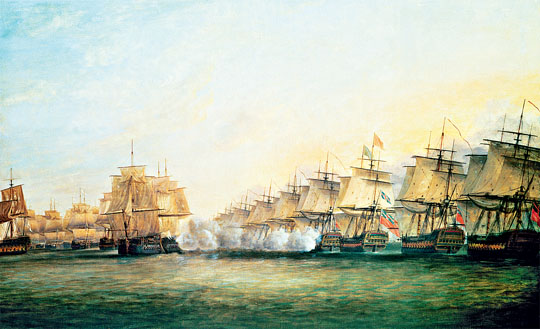Battle of Trincomalee – 3rd September 1782
In March 1778 following the signing of an alliance between France and the thirteen rebel colonies in North America (recognising their independence), the British government declared war on France. In March of the following year HMS Exeter, a 64 gun third rate ship of the line and third ship of that name to serve in the Royal Navy was dispatched to the East Indies. The ship was part of a squadron commanded by Rear Admiral Sir Richard Hughes to be based in Madras from where it was to threaten French interests in India and the East Indies. In addition to the Exeter, and Hughes’ 74 gun flagship, HMS Superb, Hughes’ squadron comprised 6 third rates, a 24 gun frigate, HMS Seahorse, and the store ship HMS Manila.
When the Dutch refused to sever trade links with the Americans and the French, Britain then declared war on the Republic, quickly taking control of a number of Dutch and French trading posts in the East Indies. In response, a naval squadron under the command of the French Admiral Pierre-Andre, Baillie de Suffren, was sent to India.
On 11th January 1782, Hughes captured the port of Trincomalee on Ceylon (now Sri Lanka) from the Dutch. Leaving the port garrisoned mostly by sepoys[1], Hughes returned with his fleet to Madras where he heard of Suffren’s arrival in Indian waters. Between mid February and the beginning of July 1782 Hughes fought 3 fleet actions against the French; Sadras, Providien and Negapatam, achieving battle honours for each. However, these engagements failed to secure a decisive victory.
On 21st August Suffren’s fleet was reinforced by two ships of the line, a frigate and a number of transports carrying 800 troops. This fleet of 15 ships of the line anchored off Trincomalee, where on the 25th August, Suffren landed 2,500 troops and invested the port’s defences from the British garrison.
On 2nd September, Hughes and his fleet of 12 ships of the line, including HMS Exeter commanded by Captain Robert Montagu, arrived off Trincomalee, unfortunately too late to prevent the surrender.
Despite the objections of his second in command and a number of his captains, Suffren decided to engage the smaller British fleet as he perceived that a decisive naval victory would leave the British colonies at the mercy of the French.
On 3rd September Suffren’s fleet sailed out to meet Hughes. Lack of discipline in the French fleet led to the commencement of the general action before its line of battle had been properly formed. Despite his superior numbers, Suffren was unable to bring this advantage to bear on the British. In centre of the line the two commanders, Hughes on the Superb, supported by; Burford, Sultan, Eagle, Hero, and Monarca, traded broadsides for an hour with Suffren’s flagship Héros, aided by Illustre and Ajax. Fearful of being overwhelmed, Suffren signalled for assistance. The captains of the St. Michel and Annibal, who had objected to the engagement, failed to give Suffren any support, while the Brilliant only gave support at long range. As a result, the Ajax had to withdraw from the line severely damaged and was replaced by the Artésien. About two and half hours into the action the Héros lost its mainmast and soon after fired off the last of its shot but continued to fire blanks.
To concentrate his strength against Suffren’s flagship Hughes had weakened both his vanguard and the rear of his line. Consequently it was the British ships at each end of the line, including HMS Exeter, which suffered greatest damage, including the loss of her Captain. The ship was to be awarded her 4th Battle Honour within 7 months for her part in the action. Heavily out-numbered Isis, Worcester, and Monmouth were badly damaged while Exeter was disabled. Towards evening the wind shifted to the advantage of the French enabling them to concentrate their strength on the centre of the British line and although a number of British ships were disabled, nightfall enabled the fleet to escape without the loss of any ships.
Although Suffren may have had the better of the fight, casualties were relatively even; British: 51 dead, 283 wounded; French: 82 dead, 255 wounded. The damage to the French fleet and the unreliability of some of its senior officers was sufficient to prevent pursuit. Suffren’s fleet sailed back to Trincomalee to make repairs. It would be another year before the British fleet regained the port of Trincomalee.
I think it is of interest to review the rival fleets in the Battle of Trincomalee, as familiar names can be seen in both the French and British forces:
Britain
- Superb, 74
- Hero, 74
- Sultan, 74
- Burford, 70
- Monarca, 70
- Eagle, 64
- Exeter, 64
- Magnanime 64
- Monmouth, 64
- Sceptre, 64
- Worcester, 64
- Isis, 50
France
- Héros, 74
- Annibal, 74
- Illustre, 74
- Orient, 74
- Ajax, 64
- Artésien, 64
- Brilliant, 64
- Bizarre, 64
- Sévère, 64
- Sphinx, 64
- Vengeur, 64
- Hardi, 64
- Saint Michel, 60
- Flamand, 50
- Hannibal, 50
- Consolante, 36
[1] Indian Infantry employed by Europeans
Image depicting the Battle, painted by; Dominic Serres
Works credited to: Dr. Stephen Sandford, HMS Exeter Association Lead Historian
